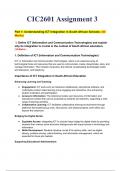CIC2601 Assignment 3
Part 1: Understanding ICT Integration in South African Schools: (40
Marks)
1. Define ICT (Information and Communication Technologies) and explain
why its integration is crucial in the context of South African education.
(10 Marks )
1. Definition of ICT (Information and Communication Technologies)
ICT, or Information and Communication Technologies, refers to an extensive array of
technological tools and resources that are used to communicate, create, disseminate, store, and
manage information. This includes computers, the Internet, broadcasting technologies (radio
and television), and telephony.
Importance of ICT Integration in South African Education
Enhancing Learning and Teaching:
● Engagement: ICT tools such as interactive whiteboards, educational software, and
multimedia content make learning more engaging and interactive, thus enhancing
student motivation and participation.
● Access to Information: The Internet provides vast resources of information and
educational content that can be accessed by students and teachers, supporting a wide
range of learning activities.
● Collaborative Learning: ICT facilitates collaborative learning environments through
platforms that enable group work, discussions, and shared projects, both within and
beyond the classroom.
Bridging the Digital Divide:
● Equitable Access: Integrating ICT in schools helps bridge the digital divide by providing
students from various socio-economic backgrounds with equal access to technology and
information.
● Skills Development: Students develop crucial 21st-century skills, such as digital
literacy, problem-solving, critical thinking, and information management, which are
essential for future job markets.
Supporting Educational Administration:
, ● Efficiency: ICT tools streamline administrative tasks such as record-keeping,
communication with parents and stakeholders, and managing student information
systems, leading to more efficient school management.
● Data-Driven Decision Making: The use of ICT enables data collection and analysis,
supporting evidence-based decision-making and policy formulation in education.
Promoting Inclusive Education:
● Special Needs Education: ICT provides tools and resources that support inclusive
education by catering to the diverse needs of learners, including those with disabilities.
Assistive technologies, for example, can enhance learning for students with visual,
auditory, or motor impairments.
● Remote Learning: ICT enables distance learning opportunities, which are crucial for
students in remote or underserved areas where access to traditional schooling may be
limited.
Preparing Students for the Future:
● Global Competitiveness: Integrating ICT in education prepares students to participate
in the global economy by equipping them with skills and knowledge relevant to the digital
age.
● Lifelong Learning: ICT fosters a culture of continuous learning and adaptability,
encouraging students to pursue lifelong education and personal development.
In summary, the integration of ICT in South African education is vital for creating a modern,
equitable, and efficient educational environment that prepares students for future challenges
and opportunities. It supports teaching and learning, promotes inclusive education, and
enhances administrative efficiency, contributing to the overall improvement of the education
system in South Africa.
2. Identify and elaborate on three significant challenges faced by South
African schools when integrating ICTs into their educational framework.
Provide specific examples if available. (15 Marks )
2. Significant Challenges Faced by South African Schools in ICT Integration
1. Infrastructure and Resources
● Limited Access to Technology: Many South African schools, especially in rural and
underprivileged areas, lack basic technological infrastructure such as computers, reliable
internet connectivity, and electricity. For instance, some schools may only have a few
outdated computers for the entire student body.
● Maintenance and Support: Even when schools have access to ICT resources,
maintaining and repairing these technologies can be challenging due to a lack of
, technical support and expertise. For example, a school might have a computer lab, but
without regular maintenance, the equipment can quickly become unusable.
2. Teacher Training and Professional Development
● Lack of Training: Teachers often do not receive adequate training in using ICT
effectively in their teaching practices. This can result in underutilization of available
technologies. For instance, a teacher may have access to an interactive whiteboard but
might not know how to integrate it into their lesson plans.
● Resistance to Change: Some educators may be resistant to adopting new technologies
due to a lack of confidence or familiarity with ICT tools. This resistance can hinder the
integration process and affect the overall learning experience. For example, teachers
accustomed to traditional teaching methods might be reluctant to incorporate digital
resources into their curriculum.
3. Financial Constraints
● Funding Issues: Integrating ICT into education requires significant financial investment,
which can be a major barrier for many schools. Limited budgets often mean that schools
must prioritize other pressing needs over technology upgrades. For example, a school
may struggle to allocate funds for purchasing new computers or paying for high-speed
internet.
● Inequitable Distribution of Resources: Financial disparities between schools can lead
to inequities in ICT access and integration. Wealthier schools may have state-of-the-art
technology, while poorer schools may lack even basic ICT resources. This disparity can
widen the educational gap between different socio-economic groups.
Specific Examples:
● Rural Schools: In many rural areas, schools face significant challenges in accessing
reliable electricity and internet connectivity. A rural school in Limpopo, for instance, may
have only intermittent power supply, making it difficult to use computers consistently.
● Urban Disparities: Even in urban areas, there can be a stark contrast between
well-funded private schools and underfunded public schools. A private school in
Johannesburg might have advanced computer labs and fast internet, while a nearby
public school could be struggling with outdated equipment and slow connections.
● Teacher Training Programs: Programs aimed at training teachers in ICT use, such as
the "ICT for Rural Education Development" (ICT4RED) project, highlight the importance
of continuous professional development. However, these programs are often limited in
scope and reach, leaving many teachers without the necessary skills.
In summary, while the integration of ICT in South African schools holds great potential, it is
hampered by challenges related to infrastructure and resources, teacher training, and financial
constraints. Addressing these issues requires coordinated efforts from the government, private




